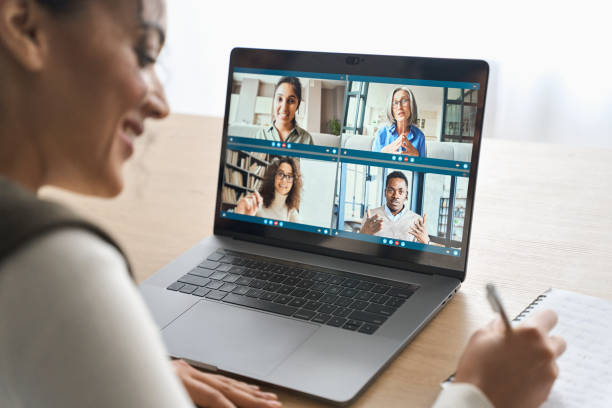Webinars are a great way to engage with your target audience and share your message. But if you’re not prepared, they can be total flops.
A great webinar script outline can make all the difference in creating a successful webinar. Here are the reasons why:
- Scripts provide a roadmap for the presenter, keeping you focused on the main points.
- It helps to keep the presenter on track, preventing tangents that can lose the audience’s attention.
- A well-crafted outline can help build suspense and anticipation, keeping viewers engaged from start to finish.
What Is a Webinar Script?
A script is a written plan for a live and automated webinar. It typically includes these four important parts that will be covered during the webinar:
- Introduction
- Webinar agenda
- Main points
- Call to action
A clear, concise script can help ensure that the entire webinar runs smoothly and provides the audience with the necessary information.
Get More Webinar Tips with StealthSeminar
Why Do You Need to Create a Script Outline?
Like most people, you probably think creating a script outline is a waste of time. After all, you already know what you want to say, so why bother with an outline?
Well, here are four reasons why creating a script outline is a great idea:
Reason #1: It’ll save you time.
Creating a script outline will help you organize your thoughts and structure your presentation. This will save time in the long run because you won’t have to keep stopping your recording from figuring out what to say next.
Reason #2: It’ll help you focus.
When you sit down to record your webinar, it can be easy to get distracted by all the things you could talk about.
A script outline will help you focus on the most important points you want to make. This way, you won’t end up rambling or forgetting the critical information you wanted to share with your audience.
Reason #3: It’ll make editing easier.
If you don’t have a script outline and something goes wrong during the recording process, it can be difficult to figure out errors.
However, it’ll be much easier to identify where things went off course if you have a webinar script template. Plus, having an outline will give you a reference point to ensure that everything flows smoothly from beginning to end.
Reason #4: It gives you a skeleton to work with.
An outline doesn’t mean your webinar has to be stiff or boring. On the contrary, it can help you be more creative and spontaneous.
By having a basic structure in place, you can allow yourself to be more flexible with the actual content of your webinar. This may be during your live or automated webinar.
How to Structure Your Webinar Content
Most people understand that webinars are powerful marketing and selling tools. But many don’t realize that the key to a successful webinar is all in the content.
Remember, how you structure your webinar content will determine how well your audience remains throughout the presentation.
Here are tips to help you get the most out of your webinars:
1. Start with a strong opening
You have a few moments to make a good impression when you start your webinar. So it’s important to start strong!
Here are ways to make sure your opening sets the tone for the rest of the presentation:
- Give an attention-grabbing opening line. Something shocking, funny, or surprising will immediately get people’s attention.
- Thank your attendees. Some people thank their webinar attendees after the presentation. However, it’s best to thank them before the event starts.
- Show them a visual or video presentation. This may be a teaser of upcoming topics or special guests appearing later in the webinar.
2. Introduce yourself and your topic
When introducing yourself, be sure to state your name and affiliation clearly. You might also want to briefly overview your experience or qualifications related to your webinar topic.
For example, to be included in the introduction script, discussing how to start a business. You might want to mention how you successfully started and ran your own business for several years.
3. Explain the problem that your webinar will address
The whole point is to provide valuable information to your webinar audience.
Here’s a thing: no one wants to sit through an hour-long sales pitch masquerading as a webinar. But if you can clearly indicate what they’ll learn and solve a specific problem, they will likely stick around.
4. Present your solution to the problem
By presenting your solution upfront, you can show your audience how your product or service can help them solve their specific problem. This helps build trust and credibility and stick around for the rest of your webinar.
5. Offer a brief overview of each section of your presentation
Think of your presentation as a journey. Just like any good journey, you want to let your audience know where you’re going and why.
That’s why it’s always best to offer a brief overview of each section.
It helps to orient your listeners and gives them a framework for understanding the information. Plus, it can help to build interest and excitement for what’s ahead.
6. Recap what you’ve covered and preview what’s coming up next
Coming to the end of a webinar can be a little bit like coming to the end of a good book. You don’t want it to end, but you’re also eager to discover what happens next.
That’s why it’s important to take a moment to recap what you’ve covered and preview the next. This will help them stay engaged and look forward to the next webinar.
7. Encourage viewers to ask questions during or after the webinar
As anyone who’s been to a live event or automated knows, questions are vital to the experience. Here are a few reasons:
- Questions help ensure that viewers pay attention and engage with the material.
- They also provide valuable feedback on what viewers do and don’t understand.
- They allow the guest speakers to clarify confusing points and offer additional information on topics of interest.
- Viewer questions can help generate new ideas and perspectives that the presenter may not have considered.
8. Wrap up the webinar
The introduction was engaging, the presentation flowed smoothly, and now it’s time to wrap things up. The conclusion of a webinar is just as important as the beginning and middle, so here are a few three elements to keep in mind.
- A strong call to action. Ensure your audience knows what you want them to do after the webinar. This includes subscribing to your mailing list, downloading a freebie, or following you on social media.
- A sense of urgency. You don’t want your audience to wait too long to take action, so create a sense of urgency. In a brief feedback session, offer a limited-time discount or bonus, or clear that spots are filling up fast if they want to participate in a coaching program or workshop.
- Gratitude. Thank your audience for their time and attention, and let them know how much you appreciate their engagement. This is a great way to leave them feeling good about the experience and eager to participate in future webinars.
Follow these tips, and you’ll be well on your way to ending your webinars on a high note with this powerful marketing tool.
Additional Script Writing Tips: How to Engage and Entertain Your Audience
So you want to write a webinar script that will engage and entertain your audience. Here are tips to get started:
Keep it short and sweet.
A webinar presentation is not the time for a long, drawn-out lecture. Respect your audience’s time by getting to the point and making your points concisely.
Use humor.
Humor can keep them. Just be careful not to overdo it, or you risk coming across as try-hard or offensive.
Use visuals.
People are visual learners, so supplement your script with engaging visuals like charts, graphs, or photos. You can also use PowerPoint slides or videos to keep people interested.
Avoid using industry jargon.
It’s fine to use some technical terms. But if your audience can’t understand what you’re saying, they will not stick around for long.
Be personal.
Share stories and anecdotes that will give your audience a sense of who you are as a person. This will help them connect with you and make them more likely to pay attention to what you say.
Use a conversational tone throughout the webinar.
Your webinar audience is not just there to listen to you. They want to feel a part of the conversation.
That’s why you must avoid sounding like you’re reading from a textbook. But instead, speak as if you’re having a conversation with a friend.
Practice.
Make sure to practice beforehand so that you sound natural and confident when delivering the webinar. The more prepared you are, the best it will be to engage and entertain your audience.
Sample Webinar Script to Help Get You Started
Here’s a short sample of the script outline to help you get started. This is just a basic outline, so feel free to add or delete sections as needed. Also, be sure to personalize the content to fit your own style and audience.
I. Introduction
“Hi everyone!
My name is ____________ and I’ll be your host for today’s webinar presentation. First, I want to thank everyone for giving me the time to join us. We’re excited to have the opportunity to share some helpful tips and information with you today.
Before we start, I just want to review a few housekeeping items.
- First, if you have any questions during the webinar, please feel free to type them into the chat box, and we’ll answer them at the end.
- Second, if you need to step away for a break at any point, no worries – we’ll be here when you get back.
- And lastly, we’ll be recording this webinar, so if you can’t make it today or want to refer back to something later, the recording will be available on our website afterward.
Now, without further ado, let’s get started.”
II. Main Content
“Insert speaker’s webinar script.”
This is where you’ll fill in the meat of your presentation. Share your knowledge and expertise on the topic at hand.
Make sure to keep things interesting by breaking up your content with video, audio, or text-based interactives (polls, surveys, Q&A). Remember – you’re the expert here, so engage with your audience and make sure they learn something new!
III. Conclusion
“Thanks for attending our webinar today!
We hope you found it helpful. Remember, [insert key takeaways here].
If you have queries, please reach out to us. Meanwhile, be sure to check out our website for more information on [topic of webinar].
Thank you again. And we hope to see you soon!”
Polish Your Script Until It’s Perfect!
The bottom line is that to deliver a successful webinar, it’s important to take the time to craft a great script. Start creating your webinar script today. And if you need help, our team is here to assist.
Just remember – outlines may not be the most exciting part of webinars, but they’ll definitely help make your webinar more successful. The better your webinar content and delivery, the more successful your live event will be.






